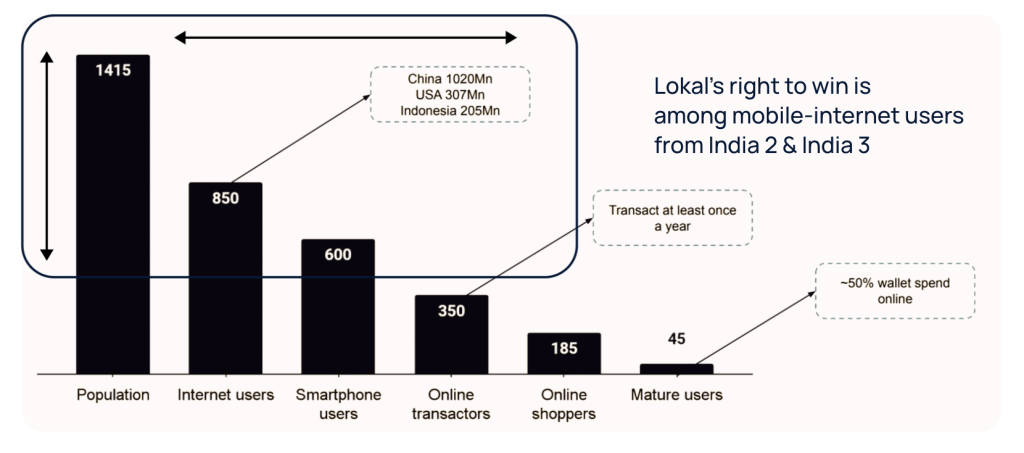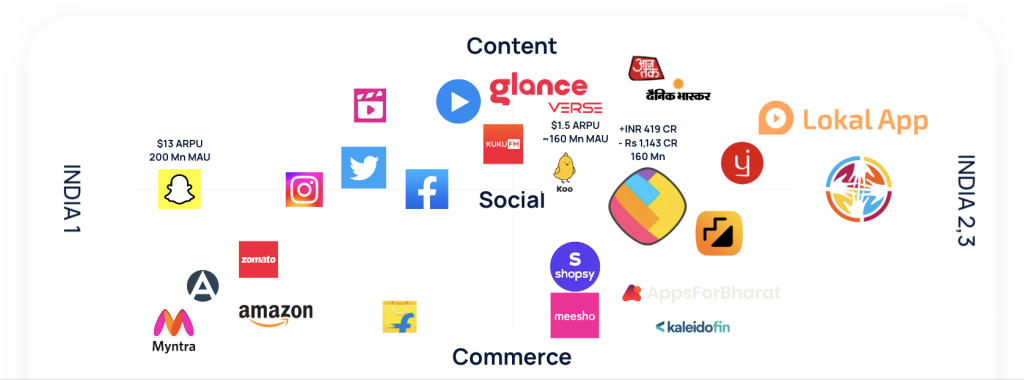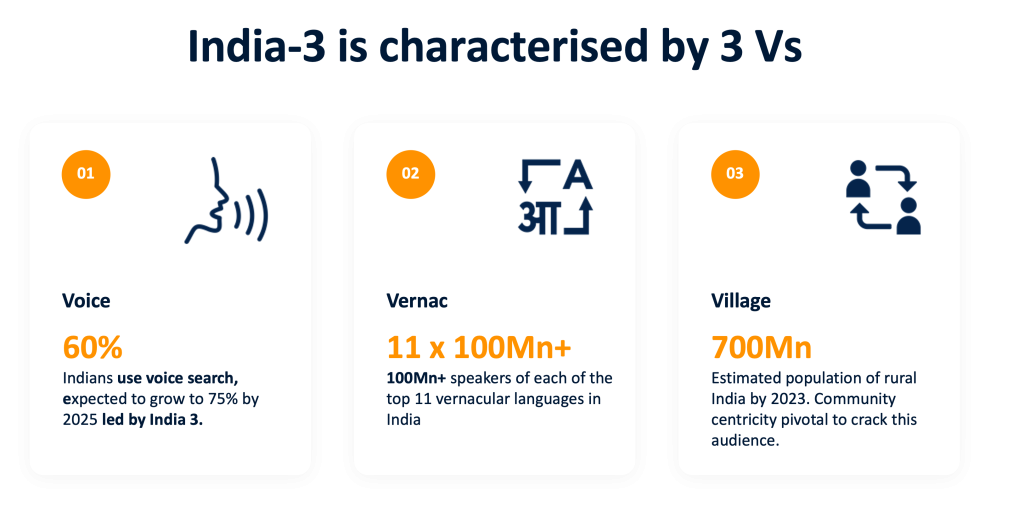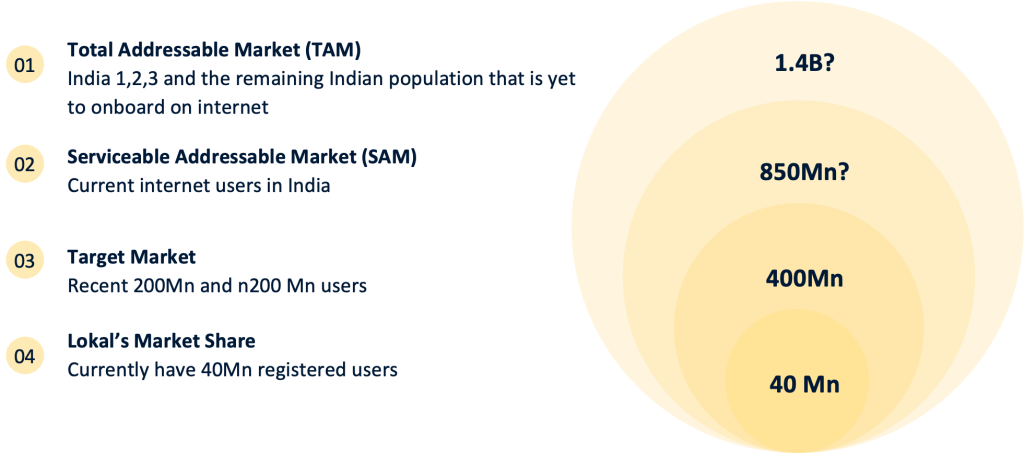In the dynamic world of Indian internet startups, Lokal has emerged as a promising app targeting the India-3 market. With a unique value proposition and a focus on solving specific problems faced by this cohort, Lokal presents an intriguing opportunity for investors. In this blog, I will explore Lokal’s potential by delving into the background of the Indian internet landscape, analyzing the market overview of content, social, and commerce apps, and uncovering Lokal’s right to win. Additionally, I will examine the cost vs. revenue dynamics across India 1, 2, and 3 apps, shedding light on the challenges and opportunities in the market.
While the analysis takes Lokal as the centre point, the playbook aims to be deemed replicable across any social, content or commerce startup focused on the India-3 market.
Too long; don’t want to read? Breeze through this pitch deck:
[Full Article covering market overview, GTM strategy & gap analysis follows]
Part 1: Market Overview
Understanding the Indian Internet Landscape:
India boasts a massive population of 1.4 billion people, with around 850 million Internet users. While these numbers are significant, there is still ample room for growth compared to countries like China and the US. Among Indian internet users, around 600 million access the internet via smartphones, and 350 million engage in online transactions. However, the market is largely untapped, with only 185 million users making online purchases, and a substantial portion of the population yet to embrace the internet.

Content, Social, and Commerce Apps: In the Indian Internet ecosystem, various types of apps cater to different user segments. Content apps, including news and OTT platforms, have gained traction, alongside social media platforms that combine content consumption and connections. Commerce apps play a vital role in driving online purchases. While the majority of apps primarily serve the India-1 and India-2 markets, a few have started catering to India-3. Notable examples include ShareChat, Glance, Meesho, Kutumb and ThreeMandi.
Lokal’s Right to Win: Lokal has identified the India-3 market as its niche and aims to address the unique problems faced by this segment. This cohort comprises users who are yet to adopt smartphones and have limited exposure to the internet. With approximately 250 million internet users falling into this category, Lokal has a significant opportunity to tap into this untapped market.
Lokal is strategically positioned to capture the attention of users who are yet to embrace smartphones and the internet. By tailoring its offerings to cater to the specific needs and pain points of this segment, Lokal can differentiate itself from competitors and tap into the immense growth potential of the India-3 market.
Cost vs. Revenue Dynamics:
Analyzing the cost vs. revenue dynamics across India 1, 2, and 3 apps provides valuable insights into the challenges and opportunities in the market. The average revenue per user (ARPU) in India-1 apps tends to be higher, reflecting the higher spending capacity and mature digital behavior of this segment. However, as we move towards India-2 and India-3, the ARPU declines significantly. This decline is attributed to the lower spending capacity and limited online transactions in these markets. Despite the decline in ARPU, the customer acquisition cost (CAC) remains relatively high, posing a challenge for app developers targeting India-3.


Key Challenges and Opportunities for Lokal:
- Scaling at a Better Cost: To succeed in the India-3 market, Lokal must prioritize cost efficiency and achieve significant growth compared to competitors. By optimizing customer acquisition and ensuring cost-effective operations, Lokal can gain a competitive edge.
- Monetizing in a Cash-Poor Market: A major challenge lies in monetizing a market where online spending is still in its early stages. Lokal must establish trust, create compelling value propositions, and encourage users to embrace online transactions, considering the expected increase in discretionary spending among middle-income households.
- Building Competitive Moats: Like any internet business, Lokal needs to develop strong competitive advantages to stay ahead of rivals. By continuously innovating, enhancing user experience, and leveraging data-driven insights, Lokal can establish barriers that protect its market position.
Lokal’s proposition in the Indian internet landscape holds significant promise, targeting the India-3 market that remains underserved. With a focus on efficient scaling, monetization strategies, and competitive differentiation, Lokal has the potential to become a dominant player in its niche. As the Indian internet ecosystem continues to evolve, Lokal’s journey will be closely watched by investors seeking opportunities in this rapidly expanding market.
Part 2: GTM Strategy for Lokal
User Acquisition:
To accelerate user acquisition and expand its user base, Lokal should adopt a multi-pronged approach that targets unique markets and leverages various channels:
- Local Partnerships: Collaborating with local community leaders, non-profit organizations, and government bodies can help Lokal establish trust and credibility among the target audience. These partnerships can facilitate grassroots marketing efforts, including workshops, awareness campaigns, and community events. Lokal should identify influential local figures and organizations that can act as advocates and help promote the platform in their respective communities.
- Vernacular Language Focus: Lokal’s strength lies in delivering news and information in regional languages. To capitalize on this, Lokal should invest in content localization, ensuring the availability of news in multiple Indian languages. This approach will attract a wider user base and address the language barrier that often hinders the adoption of digital platforms in non-metro areas. Lokal should conduct thorough market research to identify the most widely spoken regional languages in its target markets and tailor its content strategy accordingly.
- User Referral Programs: Implementing referral programs that incentivize users to invite their friends and family can help Lokal achieve organic growth. Offering rewards or exclusive features to both the referrer and the new user can incentivize word-of-mouth marketing and foster a sense of community within the Lokal platform. Lokal should carefully design and implement its referral program, ensuring that the rewards are compelling enough to motivate users to actively refer others.
User Acquisition Channels with CAC Estimate:
| Acquisition Channel | Description | Estimated CAC (per user) | Relevance for Lokal | Example |
|---|---|---|---|---|
| Digital Marketing | Reach potential users online through targeted ads | 50 INR | Expand Lokal’s user base in small cities and villages | A user in a rural village discovers Lokal through a targeted Facebook ad and starts using the platform for local news and business updates. |
| Influencer Partnerships | Increase brand visibility with popular influencers | 75 INR | Enhance Lokal’s credibility and attract users | A well-known regional influencer promotes Lokal on Instagram, leading to a surge in user registrations from their followers in small towns. |
| Referral Program | Drive organic growth through user referrals | 30 INR | Utilize existing users as advocates | When a Lokal user in a rural area refers the platform to their neighbours, both the referrer and the new user receive rewards, fostering a community of active users. |
| Partnerships with Local Businesses | Tap into established local networks for user acquisition | 60 INR | Leverage partnerships with small businesses | Collaboration with a popular local grocery store includes promotional material about Lokal in their customer orders, encouraging users to download and explore the app. |
| Community Engagement | Connect directly with local communities for user attraction | 45 INR | Engage with communities in small cities and villages | By organizing a town hall meeting in a rural area, Lokal actively involves the community in shaping the platform’s content, fostering a sense of ownership and increasing user engagement. |
Cost estimates based on personal research. Reach me at s@siddhant.site to discuss 🙂
Engagement:

Lokal’s engagement strategy should be driven by the following data-backed considerations:
- Personalized and Relevant Content: Lokal harnesses data analytics and user behavior insights to deliver personalized content recommendations to its users. By leveraging algorithms and machine learning models, Lokal tailors content to individual user preferences, ensuring relevance and freshness. Continuous curation and content updates are key to satisfying the specific interests and needs of diverse user segments.
- Gamification and User Incentives: To enhance user engagement, Lokal introduces gamification elements within its platform. This approach makes the user experience more interactive and rewarding. Users earn rewards, badges, and points through active participation and contributions to the Lokal community. This gamified approach encourages user-generated content, comments, and discussions, fostering a sense of belonging and community engagement.
- Seamless User Experience: Lokal prioritizes delivering a seamless and intuitive user experience across its mobile application and website. By optimizing page load times, minimizing friction in navigation, and providing an intuitive interface, Lokal aims to create a frictionless experience for users. Regular user feedback and usability testing help identify and address pain points, ensuring an improved user experience.
- Social Sharing and Referral Programs: Lokal empowers users to easily share articles, videos, or snippets through social sharing features embedded within its platform. By leveraging users’ social networks, Lokal expands its reach and drives user engagement. Additionally, Lokal implements referral programs that incentivize existing users to invite their friends and contacts, offering rewards or exclusive benefits for successful referrals.
- Community Building and Interactions: Fostering a strong sense of community is a priority for Lokal. The platform provides comment sections, discussion forums, and chat features, facilitating interactions among users and with Lokal’s content creators. To further strengthen the connection between Lokal and its user base, virtual or physical events, such as town hall meetings or local meetups, are organized, encouraging deeper engagement and community building.
Monetisation:
Lokal’s revenue growth strategy should focus on diversifying income streams while maintaining a sustainable business model. To achieve this, Lokal can consider the following strategies:
- Digital Advertising: Lokal can offer local businesses a variety of advertising solutions to reach their target customers. By leveraging its hyperlocal reach, Lokal can attract local businesses and advertisers seeking to target specific regions or communities. Lokal should build partnerships with regional businesses and offer targeted advertisements and sponsored content to monetize its platform while providing relevant content to its users.
- Subscription Model: Lokal can introduce a premium subscription model, offering exclusive content, personalized features, and an ad-free experience to its users. This approach can create a steady revenue stream while ensuring user engagement and loyalty. Lokal should conduct market research to determine the willingness of its target audience to pay for such premium features and content and price its subscription model accordingly.
- E-commerce Integration: Lokal can explore partnerships with local businesses and facilitate e-commerce transactions on its platform. By providing a seamless shopping experience and enabling users to discover and purchase products from local merchants, Lokal can earn a commission on each transaction. Lokal should analyze the e-commerce landscape in its target markets, identify key players and trends, and develop partnerships that align with the needs and preferences of its user base.

i) Micro-payments via subscriptions, ii) on-app ads, iii) monetising consumer intelligence off-app with & for partners
Challenges to Growth:
Despite its promising position, Lokal faces several challenges in its quest for growth:
- Regional Competition: Lokal operates in a highly competitive market, with both local and national players vying for users’ attention. To stand out, Lokal must differentiate itself by providing localized, relevant, and trustworthy content. Lokal should conduct a thorough competitor analysis to identify gaps in the market and position itself as the go-to platform for hyperlocal news and information.
- Internet Connectivity: Internet penetration and connectivity issues persist in many smaller towns and rural areas. Lokal needs to navigate this challenge by exploring offline modes of content delivery, partnering with telecom operators, or advocating for improved internet infrastructure. Lokal should collaborate with local internet service providers and government agencies to improve connectivity and ensure that its platform remains accessible to users in areas with limited internet access.
- Monetization in Non-Metro Areas: Lokal’s hyperlocal approach, while its strength, also poses a challenge in terms of monetization. Generating substantial revenue from non-metro areas may require Lokal to innovate and explore alternative revenue streams beyond traditional advertisements. Lokal should research and identify the specific needs and preferences of its target audience in non-metro areas and develop monetization strategies that align with their consumption patterns and purchasing power.
By implementing a robust GTM strategy focused on user acquisition, engagement, and revenue growth, Lokal can maximize its potential in the Indian internet landscape, unlock local opportunities, and become a dominant player in the India-3 market segment.
Part 3: Exit Scenarios & Missing Pieces
In Lokal’s quest for growth and impact, identifying the right investors and partners is crucial. This article delves into different categories of investors that Lokal can approach to secure funding and strategic collaborations. By aligning with investors who understand Lokal’s mission, target market, and growth potential, the company can unlock opportunities for expansion and drive meaningful change in the regional and hyperlocal news landscape.
- Venture Capital Firms: Lokal can seek support from venture capital firms with expertise in the Indian market, media, content, or technology sectors. Firms that have experience scaling hyperlocal platforms or digital media companies are particularly valuable. Examples of VC firms to consider include Prime Venture Partners, Kalaari Capital, SAIF Partners, Matrix Partners India, and Nexus Venture Partners.
- Impact Investors: For Lokal, impact investors who prioritize both social impact and financial returns can be ideal partners. These investors support initiatives that foster local economic development, empower marginalized communities, or promote regional language content. Notable impact funds to consider include Acumen Fund, Omidyar Network, The Rockefeller Foundation, Aavishkaar India Fund, and Elevar Equity.
- Strategic Investors: Strategic investors can provide Lokal with unique opportunities for growth and expansion. These include media organizations or conglomerates looking to expand their presence in regional and hyperlocal news markets, technology companies interested in leveraging Lokal’s expertise and user base, and partnerships with telecom operators or internet service providers seeking to offer localized content and services.
- International Investors: Investors with a focus on emerging markets, particularly those experienced in scaling businesses in diverse environments, can bring global networks, markets, and expertise to support Lokal’s expansion plans. Funds with a specific interest in the Indian market or a focus on inclusive digital content and media can be valuable partners.
- Unusual Options: Lokal may also explore unconventional investors with strategic advantages or unconventional value. This includes government-backed initiatives, public-private partnerships, philanthropic organizations, crowdfunding platforms, and local high-net-worth individuals. Examples of these include Startup India, Digital India, TiE Bangalore, Google DNI, Wikimedia Foundation, Knight Foundation, and crowdfunding platforms that enable community participation and investment.
Finding the right investors and partners is crucial for Lokal’s growth and impact. By considering venture capital firms, impact investors, strategic investors, international investors, and unique options, Lokal can secure funding, expertise, and networks that align with its mission and target market. Exploring these potential partnerships can pave the way for Lokal’s success in delivering hyperlocal news and information to underserved communities and driving positive change in the Indian media landscape.

Is the Indian 1.4 Billion+ TAM narrative an if question or a when question?
Lokal's target market is the most recent 200Mn and the next 200Mn Indian internet users.
Only a small fraction of this actually transact.
But there remain several factors that could potentially hold Lokal back from a successful fundraising round today. These missing pieces may include:
- Scalability Metrics:
- Clear evidence of Lokal’s ability to scale its user base, revenue, and market reach.
- Strong user growth metrics and a proven strategy for expansion into new regions and markets.
- Demonstrated ability to achieve sustainable revenue growth and profitability.
- Team Expertise:
- A highly skilled and experienced leadership team with a track record of successfully scaling media or technology companies.
- The team’s ability to navigate the challenges specific to hyperlocal content delivery, regional languages, and non-metro markets.
- A well-rounded team that covers key areas such as technology, content curation, marketing, and monetization.
- Competitive Differentiation:
- A clear understanding of Lokal’s competitive advantage and its unique positioning in the market.
- Evidence of barriers to entry for competitors, such as proprietary technology, strong community relationships, or extensive local content partnerships.
- An assessment of the competitive landscape and strategies to defend against existing and potential competitors.
- Brand Recognition:
- Building a strong brand identity and recognition among the target audience.
- Demonstrating user engagement, loyalty, and positive sentiment towards Lokal’s platform and content.
- Developing effective marketing and branding strategies to increase Lokal’s visibility and credibility in the market.
- Monetization Potential:
- A well-defined and tested monetization strategy that showcases Lokal’s ability to generate sustainable revenue streams.
- Evidence of successful monetization efforts, such as partnerships with advertisers, e-commerce integration, or subscription models.
- Analysis of the addressable market and potential for revenue growth in non-metro areas.
- Market and Regulatory Challenges:
- An assessment of the regulatory landscape and potential risks or challenges that may impact Lokal’s operations and growth.
- Understanding the market dynamics, user behaviour, and adoption patterns specific to non-metro areas and regional languages.
- Strategies to overcome market challenges, such as internet connectivity issues or competition from local players.
Addressing these missing pieces and presenting a compelling narrative around Lokal’s growth potential, unique market position, and ability to overcome challenges will be crucial for a successful fundraising round.
In Conclusion…
Lokal’s proposition in the Indian internet landscape holds significant promise, particularly as it targets the underserved India-3 market. By adopting a comprehensive go-to-market (GTM) strategy that focuses on user acquisition, engagement, and revenue growth, Lokal can unlock its full potential. Leveraging local partnerships, vernacular language focus, user referral programs, and community engagement, Lokal can accelerate user acquisition and establish a strong presence in the target markets.
As Lokal embarks on its journey of growth, investors keen on the Indian market and the India-3 segment should closely monitor its progress. Lokal’s unique positioning, coupled with its GTM strategy and revenue growth potential, make it an attractive investment opportunity. Investors with a deep understanding of the Indian market, regional and hyperlocal news segments, and a commitment to social impact can play a pivotal role in supporting Lokal’s growth and impact.
With a clear vision, strategic execution, and the support of aligned investors, Lokal has the potential to become a dominant player in its niche, shaping the future of the Indian internet landscape. As Lokal navigates the challenges and opportunities presented by the Indian internet ecosystem, it has the opportunity to transform the way people access and consume news and information in non-metro areas. By bridging the digital divide and empowering local communities, Lokal can drive positive change and make a lasting impact in the lives of millions of Indians.
